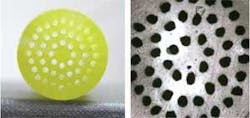MID-IR OPTICAL FIBERS: Silver halide modal filter to help find exoplanets

An improved form of an optical component called a modal filter has been developed by researchers at the Jet Propulsion Laboratory (JPL; Pasadena, CA) and Tel Aviv University (TAU; Tel Aviv, Israel); the filter, which takes the form of a single-mode silver halide optical fiber, is intended to aid the search for life outside the Solar System.1
Although exoplanets (planets orbiting stars other than the Sun) have been optically detected in various ways, the ones that have been found so far tend to be much larger than Earth–and many times larger than Jupiter. In addition, as a result of the techniques used, the exoplanets’ orbits are usually either extremely close to (a few million miles) or very far away from (farther than the orbit of Jupiter) their parent stars.
One optical technique that has the potential to detect exoplanets more Earthlike in size and orbit–and presumably, in their capacity to harbor life–is nulling interferometry, in which the light from a star is interferometrically quenched while the light from any associated planets passes through, mostly unaffected, to the image plane. For example, one portion of NASA’s conceptual Terrestrial Planet Finder (TPF) project is a spaceborne nulling interferometer operating in the mid-IR.
To work well, a nulling interferometer must be able to filter a portion of the starlight to suppress its wavefront aberrations, ideally producing a single-transverse-mode output throughout a broad wavelength range. Although pinholes have already been used for this purpose, they work best only over narrow bandwidths, and in addition pass some low-frequency aberration components.
Why silver halide?
Much more effective for filtering out every last bit of aberration is a single-mode fiber, in which all higher modes soon end up in the cladding, where they can be absorbed or otherwise gotten rid of. The JPL/TAU group, which is developing modal filters for NASA’s TPF, chose silver halide as a fiber material for its excellent transmission in the 12 to 20 µm wavelength range. (The TPF will operate over the 6 to 20 µm range; the 6 to 12 µm portion of that range can be covered by a chalcogenide-fiber modal filter.)2
Mid-IR was chosen for the TPF for more than one reason. “The motivation to observe at mid-infrared wavelengths is threefold: the star-planet contrast is more favorable than at shorter wavelengths; there are clear biomarkers; and the optical tolerances of the observatory are relaxed,” says Alexander Ksendzov, one of the JPL researchers.
The fibers were manufactured from silver chloride bromide (AgClxBr1-x) crystals (x is the molar fraction of Cl), with x chosen to be 0.32 for the core and 0.30 for the inner cladding, creating a refractive index difference of 0.0047. The fiber’s outer cladding had an x of 0.05. A rod-in-tube preform was drawn to create a fiber with a core diameter of 50 µm, an inner-cladding diameter of 250 µm, and an outer-cladding diameter of 900 µm. The outer cladding was exposed to UV light to create an absorbing layer. Fibers of 4.5, 10.5, 15, and 20 cm lengths were fabricated.
To test the fibers, a collimated beam from a 10.5-µm-emitting quantum-cascade laser was reflected off a mirror with a step in its center, creating an antisymmetrical mode that ideally should not couple at all to a single-mode fiber when aligned to its center. Scanning the mode across the fiber’s input face produces a minimum core transmission that indicates the fiber’s modal-filtering efficiency (a lower minimum is better). The output power was measured both with and without the use of a digital aperture blocking the output end’s cladding to suppress the effects of cladding modes (digital apertures with various sizes were tried).
As expected, the longer fibers were better filters, and the digital aperture helped. With the digital apertures, the fibers with lengths of 10.5, 15, and 20 cm achieved a modal suppression of 15,000 or greater (a suppression of only 300 is required for the TPF).
Photonic-crystal fibers and more
The researchers are pursuing silver halide photonic-crystal fibers, too, as well as other variations of the technology (see figure). “At The Tel Aviv University, we are planning to work on step-index fibers, improve the transmission through the core, and at the same time increase the attenuation of radiation through the cladding,” says Ksendzov. “We will do the same with photonic-crystal fibers. We will also try to develop single-mode flat waveguides. In addition, we plan to try to fabricate integrated optical circuits based on silver halides, which could be useful for nulling interferometry.”
REFERENCES
- A. Ksendzov et al., Appl. Optics 47, p. 5728 (2008).
- A. Ksendzov et al., Appl. Optics 46, p. 7957 (2007).

John Wallace | Senior Technical Editor (1998-2022)
John Wallace was with Laser Focus World for nearly 25 years, retiring in late June 2022. He obtained a bachelor's degree in mechanical engineering and physics at Rutgers University and a master's in optical engineering at the University of Rochester. Before becoming an editor, John worked as an engineer at RCA, Exxon, Eastman Kodak, and GCA Corporation.